Figures & data
Figure 1. Water content (a), relative water content (b), expressed sap osmotic potential (c), and calculated osmotic adjustment (OA) (d) for segments of FEFL of wheat (cv. Hartog) in two PEG 8000 treatments (0 and − 0.5 MPa) in the basal incubation solution, basal plus 10 mM KCl, basal plus 0.4 mM NaCl, and basal plus 10 mM NaCl at 0 (initial) and 48 h of treatment. Values are means ± SE (n = 3). 0 MPa □, −0.5 MPa ■. Some error bars are too small to see. Significant differences (P < 0.05) between PEG treatments and amongst KCl and NaCl treatments were indicated by different letters.

Figure 2. Concentrations of K+ (a), Na+ (b), and Cl− (c) in segments of FEFL of wheat (cv. Hartog) in two PEG 8000 treatments (0 and − 0.5 MPa) in the basal incubation solution, basal plus 10 mM KCl, basal plus 0.4 mM NaCl and basal plus 10 mM NaCl at 0 (initial) and 48 h of treatment. Values are means ± SE (n = 3). 0 MPa □, −0.5 MPa ■. Some error bars are too small to see. Significant differences (P < 0.05) between PEG treatments and amongst KCl and NaCl treatments were indicated by different letters.
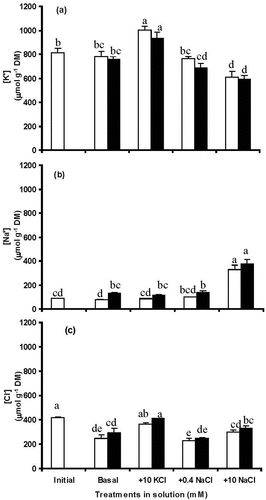
Figure 3. Concentrations of glycinebetaine (a), proline (b), and (c) total soluble sugars for segments of FEFL of wheat (cv. Hartog) in two PEG 8000 treatments (0 and − 0.5 MPa) in the basal incubation solution, basal plus 10 mM KCl, basal plus 0.4 mM NaCl, and basal plus 10 mM NaCl at 0 (initial) and 48 h of treatment. Values are means ± SE (n = 3). 0 MPa □, −0.5 MPa ■. Some error bars are too small to see. The scale of Y axis in Figure 3(c) is 3-fold that in Figure 3(a,b). Significant differences (P < 0.05) between PEG treatments and amongst KCl and NaCl treatments were indicated by different letters.
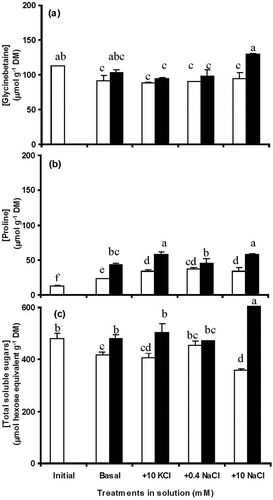
Figure 4. Water content (a), relative water content (b), expressed sap osmotic potential (c), and calculated osmotic adjustment (OA) (d) for segments of FEFL of wheat (cv. Hartog) in two PEG 8000 treatments (0 and − 0.5 MPa) in the basal incubation solution, basal minus N, basal plus 0.4 mM NO3− and basal plus 10 mM NO3− at 0 (initial) and 48 h of treatment. Values are means ± SE (n = 3). 0 MPa □, −0.5 MPa ■. Some error bars are too small to see. Significant differences (P < 0.05) between PEG treatments and amongst N supply treatments were indicated by different letters.
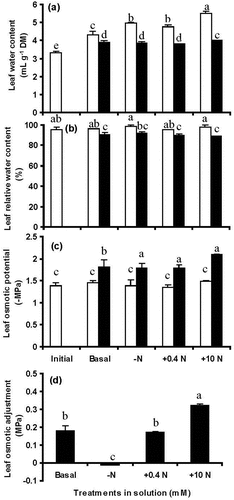
Figure 5. Concentrations of K+ (a), Na+ (b), and Cl− (c) in segments of FEFL of wheat (cv. Hartog) in two PEG 8000 treatments (0 and − 0.5 MPa) in the basal incubation solution, basal minus N, basal plus 0.4 mM NO3− and basal plus 10 mM NO3− at 0 (initial) and 48 h of treatment. Values are means ± SE (n = 3). 0 MPa □, −0.5 MPa ■. Some error bars are too small to see. The scale of Y axis in Figure 5(a) is 2-fold that in Figure 5(b,c). Significant differences (P < 0.05) between PEG treatments and amongst N supply treatments were indicated by different letters.
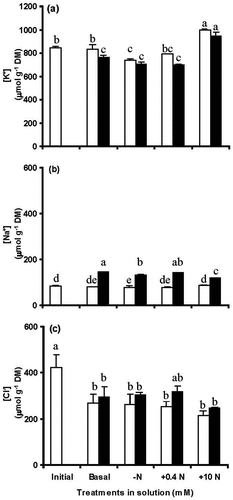
Figure 6. Concentrations of glycinebetaine (a), proline (b), and total soluble sugars (c) for segments of FEFL of wheat (cv. Hartog) in two PEG 8000 treatments (0 and − 0.5 MPa) in the basal incubation solution, basal minus N, basal plus 0.4 mM NO3− and basal plus 10 mM NO3− at 0 (initial) and 48 h of treatment. Values are means ± SE (n = 3). 0 MPa □, −0.5 MPa ■. Some error bars are too small to see. The scale of Y axis in Figure 6(c) is 3-fold that in Figure 6(a,b). Significant differences (P < 0.05) between PEG treatments and amongst N supply treatments were indicated by different letters.
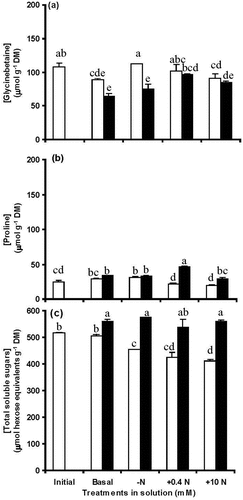
Data availability statement
[dataset] Wade, Len (2022). Solute contributions to osmotic adjustment in leaf segments of wheat (Triticum aestivum L.) exposed to polyethylene glycol-induced water deficit. Mendeley Data, V1. http://dx.doi.org/10.17632/hm4d3pz6mb.1.
